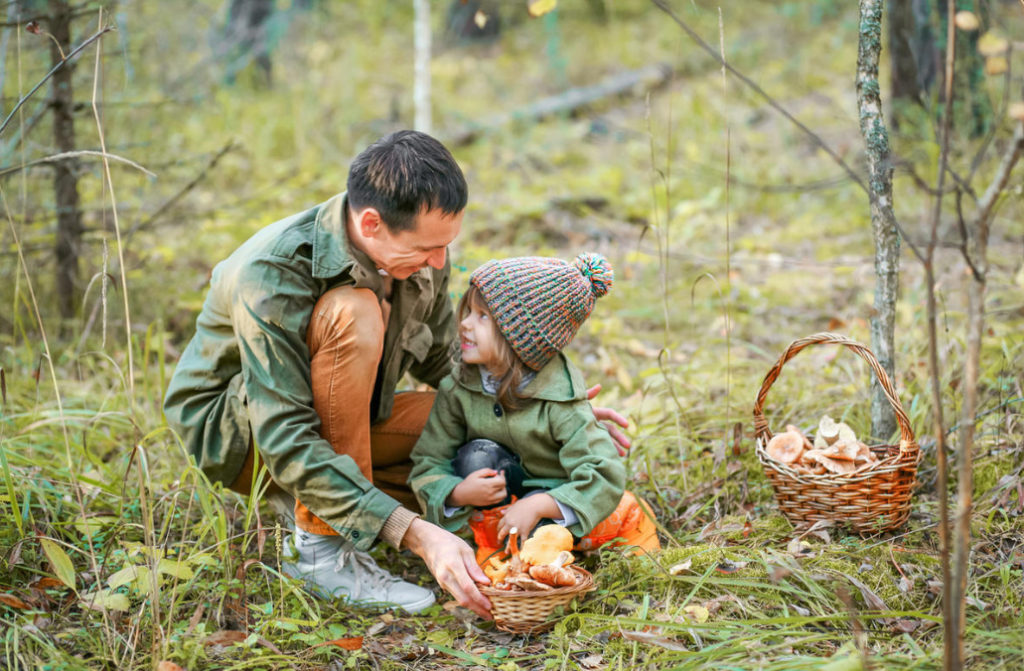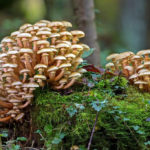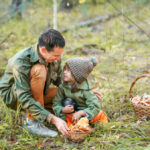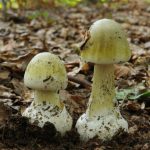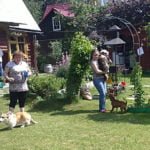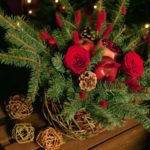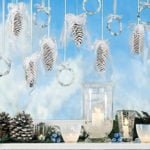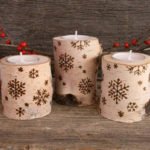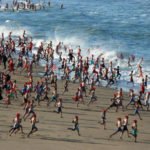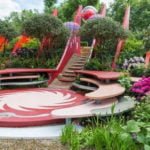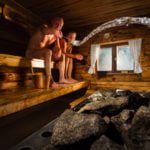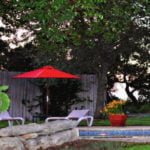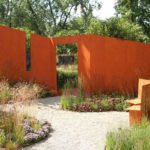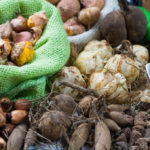Armillaria mellea, f. borealis
Season: August-October.
Habitats: coniferous and mixed woods, on wood of coniferous breeds, grow huge groups.
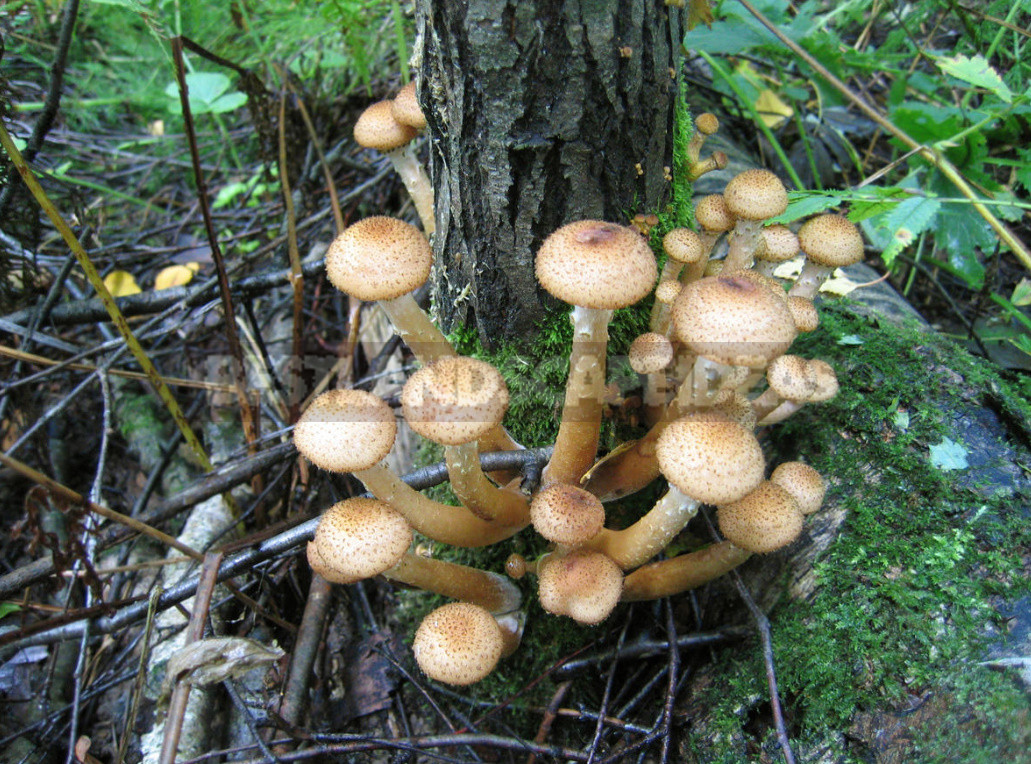
Species description:
- hat 2-7 cm in diameter, first round-convex, later prostrate, sometimes with a tubercle in the middle. A distinctive feature of the species: cream-yellow or yellow-brown hat with numerous small brown scales that look like brownish dots. The cap has 2-3 concentric zones, each of which has a predominant color: cream, light brown, yellow-brown, mustard. The edges of the cap are first wrapped in, later-straightened; striped. In young specimens, the cap is connected to the leg by a white film, which later hangs in a ring around the leg;
- leg 4-10 cm tall and 5-10 mm thick, dense, cylindrical along the entire length, first flake-scaly, later almost naked. At the top is a well-defined ring with a fringed edge. The leg is usually exactly the same color as the hat. The second distinctive property of the species-crowding: mushrooms grow “clusters”, many pieces together. In this case, the legs often grow together at the rhizome;
- the flesh is dense, thin-fleshed, white, does not change color at the break, with a pleasant smell and taste;
- the plates are attached, slightly descending along the leg, thin, of medium frequency, whitish-yellowish in young specimens, brownish in maturity, often covered with rusty spots.
Variability: zone hats can be bright yellow-brown or bright mustard in dry weather, in wet and cold color of the hat changes to dark brown.
Resemblance to inedible species: it is similar to Hypholoma capnoides, which is distinguished by significantly more frequent plates of gray or gray-brown color with an unpleasant odor.
Edibility: edible, assigned to the 2nd and 3rd categories.
Armillaria mellea, f. sinapina
Season: August-October.
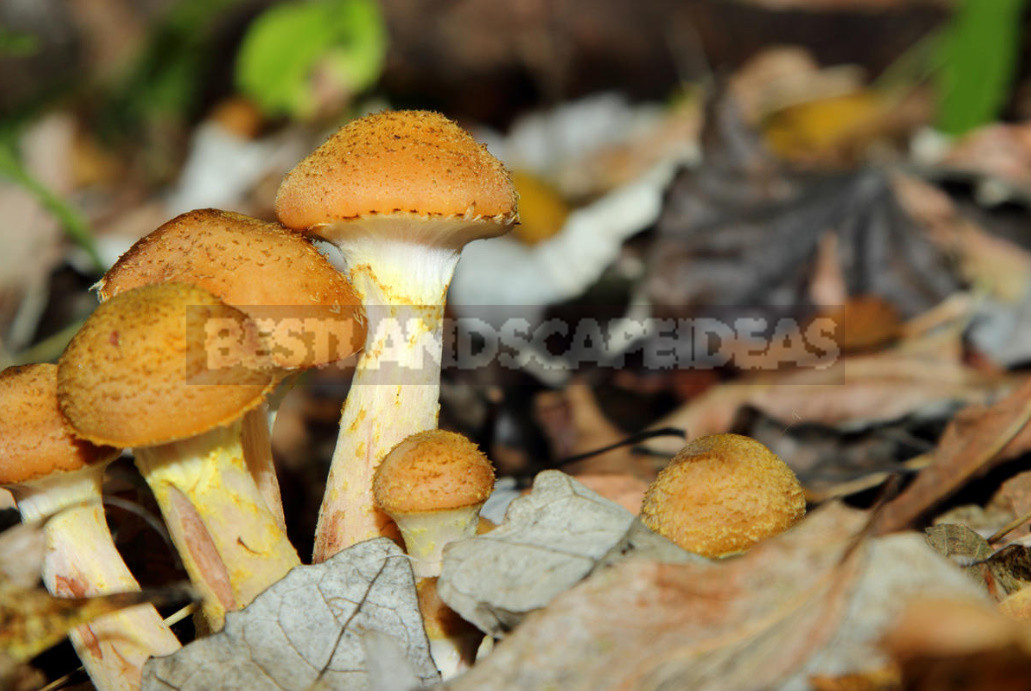
Habitats: coniferous and mixed woods, on wood of coniferous breeds, grow huge groups.
Species description:
- hat 3-8 cm in diameter, first round-convex, later prostrate, sometimes with a tubercle in the middle. A distinctive feature of the species is considered to be a mustard-colored hat with numerous small brownish scales. The edges of the hat are first wrapped inside, later-straightened, striped. In young specimens, the cap is connected to the stem by a white film, which, as the fungus grows, remains a ring at the top of the stem;
- leg 4-10 cm tall and 5-12 mm thick, dense, cylindrical, slightly expanding at the base. The second distinctive property of the species is considered to be the color of the legs: mustard, but not as smooth as on the hat, on top – lighter areas, and at the base – more dense and dark. In the upper part of the leg there is a well-defined whitish ring with a fringed edge;
- the flesh is dense, thin-fleshed, white, does not change color at the break, with a pleasant smell and taste;
- the plates are attached, slightly descending along the leg, thin, of medium frequency, whitish-yellowish in young specimens, brownish in maturity, often covered with rusty spots.
Variability: the hat can be bright mustard, but there is also a light yellow-brown in dry weather, in wet and cold its color darkens to mustard-brown.
Resemblance to inedible species: it is similar to Hypholoma capnoides, which is distinguished by significantly more frequent plates of gray or gray-brown color with an unpleasant odor.
Edibility: belong to the 3rd category.
Methods of preparation: drying, cooking, pickling, salting.
Lactarius resimus
Season: July-September.
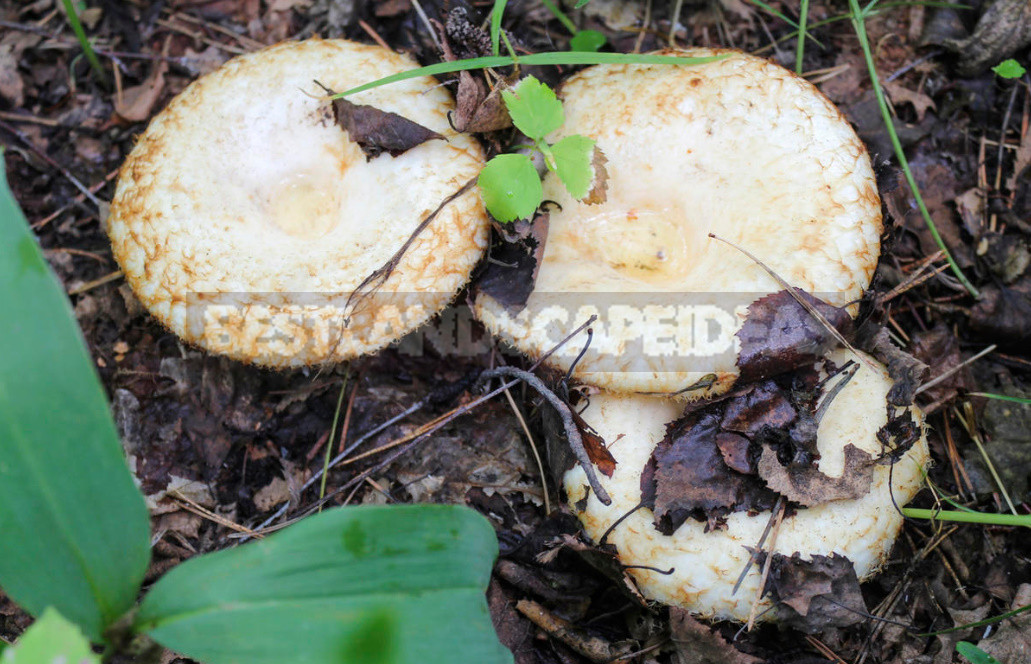
Habitats: birch and mixed with birch forests; form mycorrhiza with birch, grow groups.
Species description:
- hat diameter 6-15 cm, sometimes up to 20 cm, fleshy, first with steeply wrapped down the edges and a recess in the center, later – convex-prostrate, with a depressed Central area. The distinctive property of the species are densely fluffy or shaggy edges and milky white color of the cap, which eventually becomes yellowish or cream, with or without subtle areas. On the hat may be yellowish spots;
- leg 3-9 cm long, 1.5-3.5 cm diameter, cylindrical, smooth, white, sometimes yellowish or reddish at the base;
- the flesh is white, brittle, with a pleasant fruity smell, at the break allocates a white milky juice of pungent taste, yellowing in the air;
- plates of 0.5-0.8 cm wide, decurrent on the stem, often white at first, later yellowish. Spore powder is white.
Similar species: Lactarius resimus is similar to Lactarius scrobiculatus, which may also have only slightly shaggy edges, a Golden yellow or dirty yellow color, but no fruity pulp odor.
Edibility: excellent tasty mushrooms 1 category.
Methods of preparation: salting after pretreatment by boiling or soaking, you can marinate.
Lactarius necator
Salty Lactarius necator are famous for excellent taste and appetizing crunch, so deservedly fell into the category of delicious snacks. These fungi grow in swampy areas or near wet areas of the forest, often near forest paths.
Season: August-November.
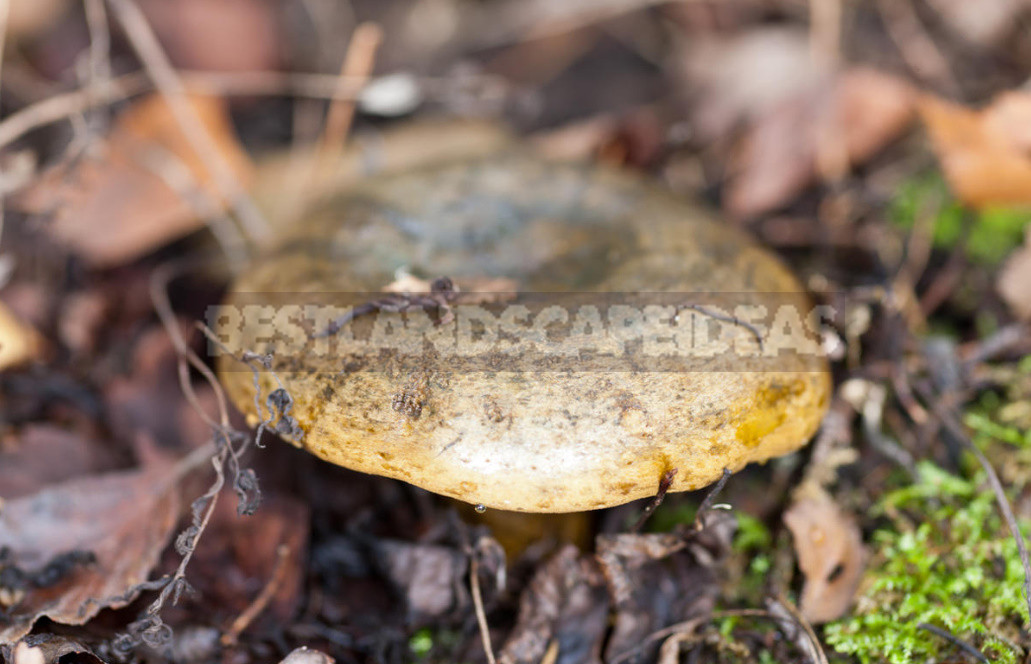
Habitat: mixed and coniferous forests, often in clearings; form mycorrhiza with birch, usually growing in groups.
Species description:
- hat diameter of 5-15 cm, sometimes up to 22 cm, first convex, then smooth, with a depressed middle, young specimens with bent down felt edges (may be cracked), which then straightened; in wet weather, sticky and mucous, with faint concentric zones. A distinctive feature of the species is considered to be the dark color of the hat: olive-brown or greenish-black;
- leg 3-8 cm tall and 1.5-3 cm thick, narrowed down, smooth, mucous, generally the same color as the cap, but at the top lighter;
- the flesh is white, the slice turning brown or darkening, burning abundantly secretes a white milky SAP. Spore powder yellowish;
- plates frequent, narrow, descending on the leg, fork-branched, whitish or pale yellow, often with a greenish tinge, when pressed blacken.
Variability: the color of the cap (depending on the degree of maturity and geographical area) varies from completely black to brown-black.
Edibility: assigned to the 3rd category.
Methods of preparation: salting after pretreatment (boiling or soaking). When salting, the color of the cap becomes cherry-red or purple-red.
Lactarius
In August, you can find such wonderful mushrooms as redheads. They belong to the first and second categories of edible qualities. Lactarius can most often be found under small fir trees growing in a clearing in front of the forest.
Lactarius deliciosus
Season: July-October.
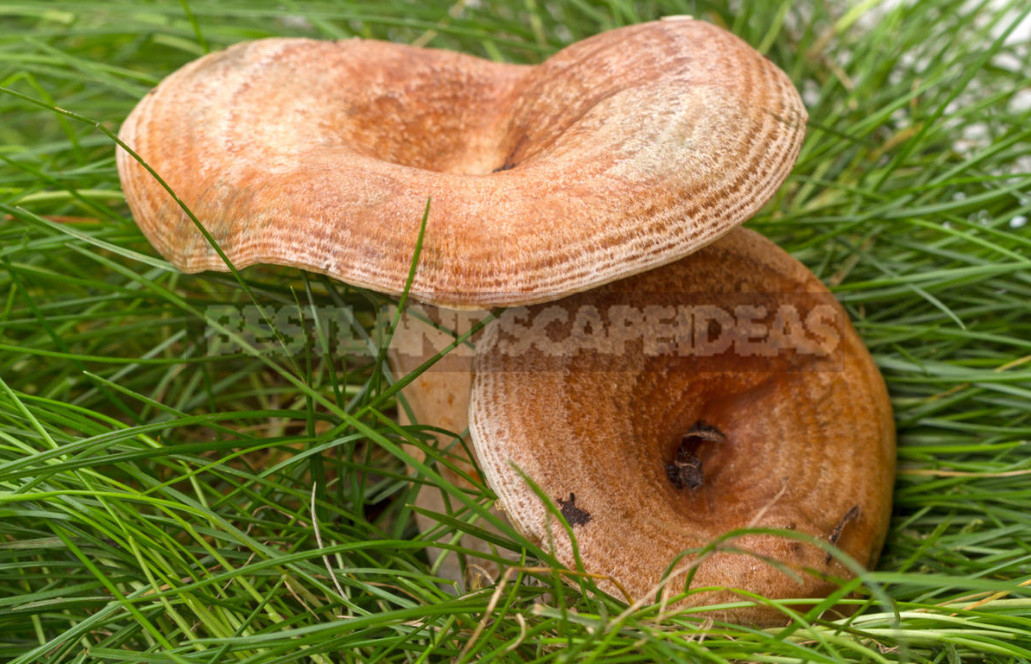
Habitats: young spruce forests on calcareous and acidic soils, grow groups.
Species description:
- hat diameter 2-8 cm, sometimes up to 10 cm, first convex-notched, later almost flat, with a small depression in the middle. A distinctive feature of the species is a red, orange-red hat with significant spots (or zones) of greenish and blue-green color. The edges of the cap are first bent downwards, on the surface concentric circles are faintly visible;
- leg 3-6 cm tall, 0.7-2 cm thick, smooth, hollow, highly brittle, cylindrical, of the same color with the cap; in the area of attachment of the plates has a lighter area;
- the flesh is orange or yellowish, loose, damaged and later greenish. The flesh of the leg is whitish. The second distinctive property of the species is a bright milky juice of carrot-red color, with a fruity smell;
- plates attached to the leg, thick, notched or slightly descending, narrow, sometimes branched. The color of the plates is orange-yellow, with greenish and blue-green spots. When pressed, the plates turn green. The spore powder is light ochreous.
Similarity with other species: the spruce form Lactarius deliciosus is dominated by darker (compared to the pine form) tone hats, there are areas of bluish-greenish color, and the flesh is loose.
Edibility: good mushrooms 2nd category.
Methods of preparation: these mushrooms are very tasty and fragrant; good for marinating, salting, frying.
